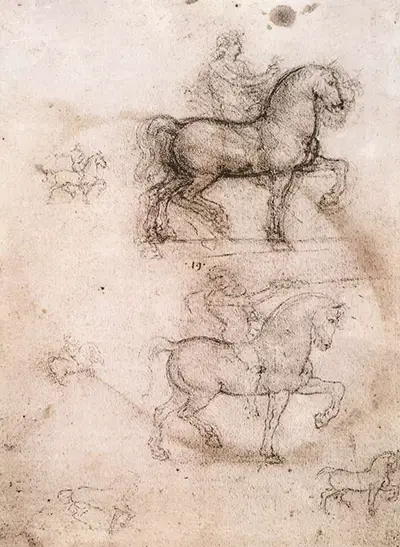Trivulzio Monument
When thinking about Leonardo Da Vinci, we usually associate him with works such as the Mona Lisa and the Last Supper. Da Vinci was, however, a man of many talents. He was not just an artist. As well as being mathematician and engineer he was also a sculptor. Da Vinci learnt his skills as a sculptor in his youth and would continue for many years after. While sculptures may not immediately come to mind when thinking about Da Vinci, there are two major projects he is probably best known for. One of those projects was for the Trivulzio Monument. The other was a bronze statue of a horse and rider for Francesco Sforza.
Trivulzio Monument
In 1499, Gian Giacomo Trivulzio was the commander who led the French forces of Louis XII in the invasion of Milan. As Governor of Milan, Trivulzio later hired Leonardo Da Vinci to design and build a monument that would be his tomb. The project may also have been the result of Trivulzio wanting a mortuary chapel for his family.
While there are no details on when Da Vinci worked on the project, it is likely that the date was sometime around 1511. The commission Da Vinci received from Trivulzio was to be for an equestrian monument that would also serve as his tomb. The result was that the Trivulzio Monument would be a life-size bronze horse and rider. The statue would stand on a marble base that housed a sarcophagus. For Da Vinci, this was to be his second attempt at a statue of a horse and rider. The first having been the Sforza monument.
There is nothing to show that Da Vinci started work on the Trivulzio monument or that he finished it. What is known about it today comes from Leonardo Da Vinci’s notebooks and drawings. Why he did not complete the statue may have been due to fears of a war breaking out against the French occupancy of Milan. What details there is about the design of the monument comes from Da Vinci’s notebooks. Amongst all the notes is a full breakdown of the cost of the various elements that would go into the Trivulzio monument. It notes shows that it was to be a ‘bronze horse and rider’. It would stand on a marble base that would have eight columns and sculptured figures. The monument would also have a resting figure of Gian Giacomo Trivulzio.
Trivulzio Monument Studies
There is nothing to confirm that Leonardo Da Vinci started work on the Trivulzio monument. Like his other projects, he did carry out a number of studies. The Trivulzio monument studies include both drawings as well as notes. It is from the pen and ink drawings and notes that we get much of the knowledge we have today about the monument.
The main drawing best known for the Trivulzio monument is one that has a sketch of horse and rider in profile. The statue’s profile shows the horse and rider in different positions and looking to the right. Also, the drawing has designs on it of three different bases for the figure. Another of the illustrations linked to the Trivulzio monument has text with instructions for casting a statue of a bronze horse and rider. As well as a list of chemicals, it also has three diagrams showing the machinery for casting the statue.
On Da Vinci’s death, the drawings for the Trivulzio monument were left to his student Francesco Melzi. Ownership of the drawings later transferred from Melzi’s heirs following their purchase by Pompeo Leoni. By 1630, Thomas Howard, 2nd Earl of Arundel became the owner of the drawings. The drawings for the Trivulzio monument are now part of the UK’s Royal Collection. This likely due to their acquisition by the English King Charles II in 1690.
Bronze Horse
Da Vinci’s knowledge of the equestrian form came from many years of study. His notebooks and drawings contain a lot of detail about horses. They show not just the anatomy but also the movement and proportions of a live horse. In his work on the Sforza monument, he did a lot of detailed drawings about horses as well as the rider. These are likely to have featured in the preparatory studies he later did for the Trivulzio monument.
When it comes to bronze casting, text and drawings show that Da Vinci had a lot of practice in the techniques involved. The issue was that he wanted to cast the horse in a single piece. Given that the statue was to be life-size, there was a view that the large size of the horse would be an impossible problem to resolve. Based on available information, it appears that he did not find a solution to the problem of casting it in one piece.
Sculptures Legacy
We know that Da Vinci never finished the Trivulzio monument. Equally, none of his commissions to deliver sculptures such as the Trivulzio and Sforza monuments were ever fully completed. Despite this, his work did influence other great artists who came after him. During the 16th century, Da Vinci’s influence was a major factor in promoting equestrian statues. One example of this comes through in a small bronze statue of a galloping horseman on view in Budapest. Some think the horse and rider might have been by Giovanni Francesco Rustici, one of Da Vinci’s students rather than Da Vinci himself.
